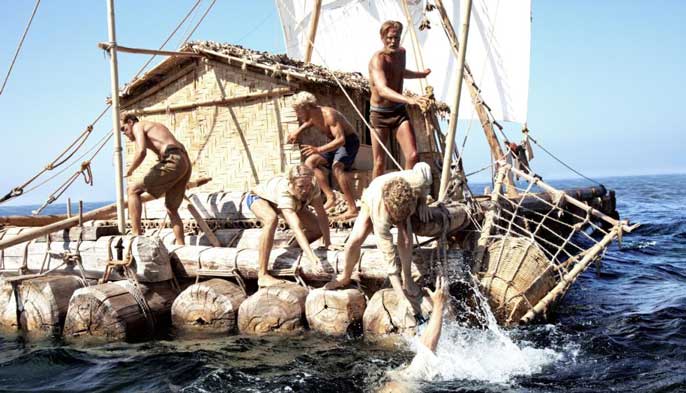
|
History of Ships Recreating History Jean Vaucher (August 2018) |
- Prehistoric Boats
- Rafts
- Reed Boats
- Animal Skin Floats
- Dugouts Canoes
- Kayaks & Coracles
- Ocean Crossings in Primitive Boats
- Polynesians ( 3000 BCE - 1000AD )
- Viking Ships
- The Age of Discovery
- 19th Century
Thor Heyerdahl
In 1947, the Norwegian ethnographer, Thor Heyerdahl, started a trend by sailing the Kon-Tiki, a balsa-log raft, from South America to the Tuamotu Islands. The expedition was designed to demonstrate that ancient people could have made long sea voyages, creating contacts between separate cultures. Since that time, many other expeditions have attempted ocean crossings using primitive techniques. [Wikipedia]The Kon-Tiki Expedition (1947)
Accepted theory holds that Polynesia was colonised from southeast Asia around 1000AD; but, based on similarities between statues on Easter Island and others in Bolivia, Heyerdahl believed that there had been contact from South America. To support that claim, he sailed from Peru with five other adventurers on a raft built in native style from balsa wood, bamboo, and hemp. After 101 days and 4,300 nautical miles on the open sea they arrived in the Tuamota Islands. [Wikipedia]
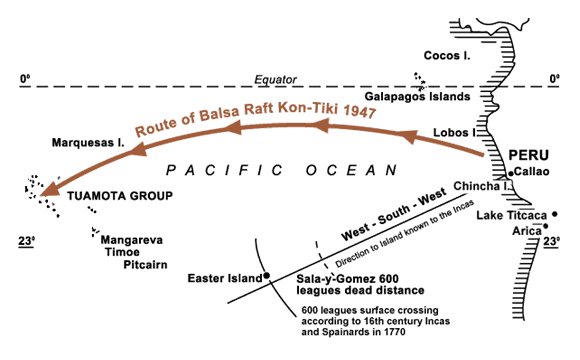
Kon-Tiki Expedition (1947) |

Kon-Tiki, Balsa Logs and Sail |
RA-II : Crossing the Atlantic on a Reed Boat (1970)
In 1970, Heyerdahl was at it again. Proving that a reed boat of Egyptian design could reach South America. Could Aztec pyramids have been influenced by Egyptians ?
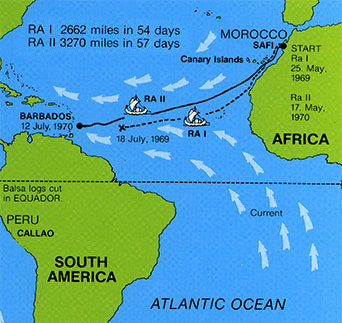
RA-II (1970) |
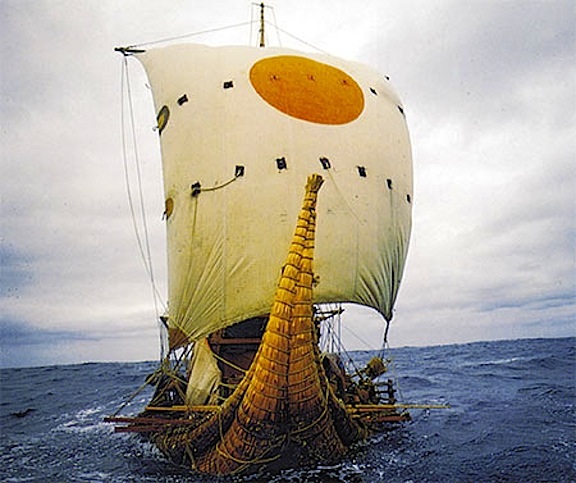
Ra II - Reed Boat |
The Brendan Voyage (Severin, 1976)
This expedition sought to replicate a much later exploit: Saint Brendan's (c. 489-583) seven-year voyage across the Atlantic in a leather boat to a new land and his return.The Brendan, a 36-foot, two masted boat was built in traditional fashion of Irish ash and oak, hand-lashed together with nearly two miles (3 km) of leather thong, wrapped with 49 tanned ox hides, and sealed with wool grease. Between May 1976 and June 1977, Tim Severin and his crew sailed the Brendan 4,500 miles (7,200 km) from Ireland to Peckford Island, Newfoundland, stopping at the Hebrides and Iceland en route. [Wikipedia]
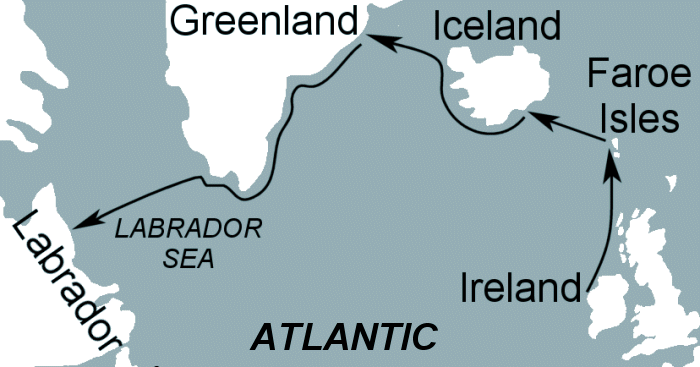
Route of the Brendan |
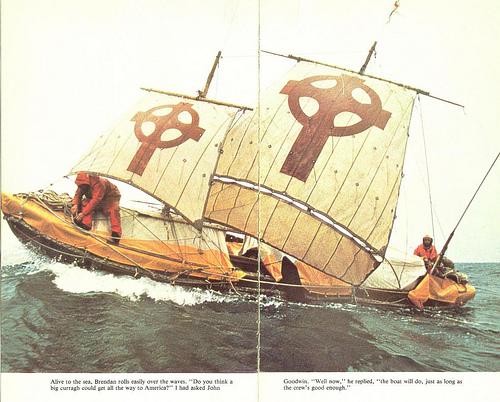
The Brendan Leather Boat |
Experiments in the Mediterranean
Recent digs have shown that most islands in the Mediterranean were visited or settled by Stone Age people - way before the classic civilizations of Egypt, Mesopotamia and Greece. On Cyprus, agricultural settlements dating to 9,000BC were found and, the first settlements on Crete (~ 7,000BC) precede the Minoan civilization by more than four millennia.
Island settlement implies some navigation legs over 100km in very primitive craft. There is also evidence of repeated trade (in obsidian) between some islands and the mainland. In recent years, experimental archeologists have repeated these voyages in bith reed craft and dugout canoes.
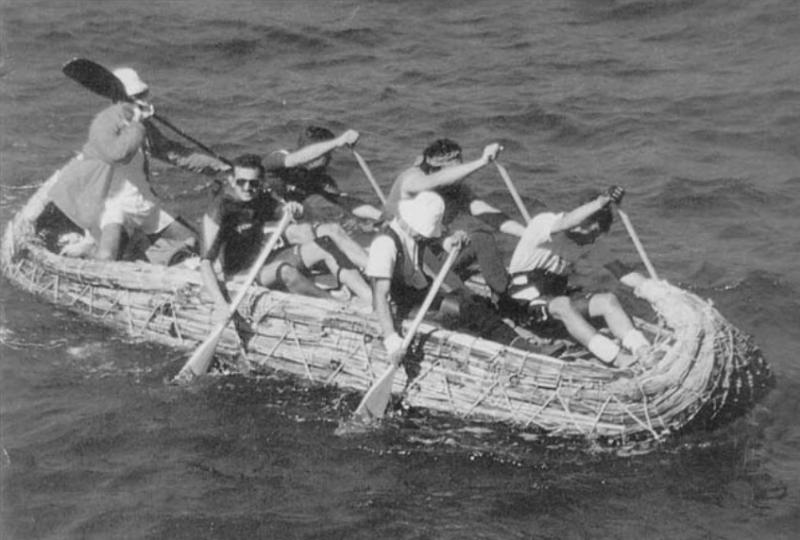
Reed "Papyrella" (Tzalas 1988) [Ref] |
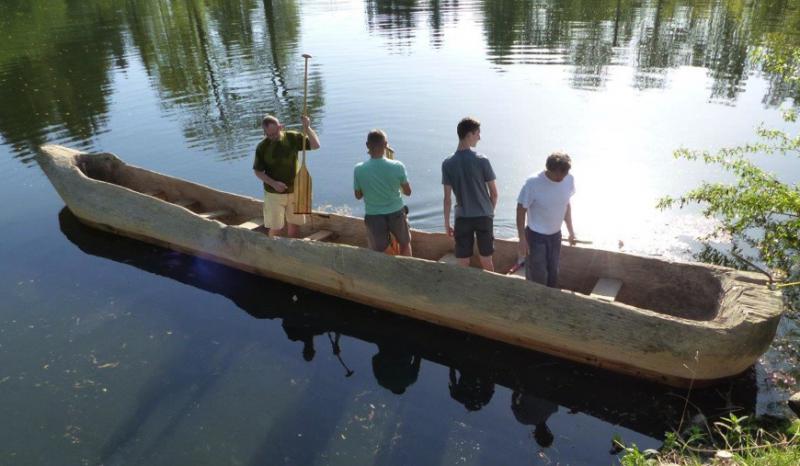
Dugout Canoe "Monoxylon" Tichy, 1995 & 1998 [Ref] |
The First Mariners Projects (1998-2008)
The First Mariners Projects showed how Homo Erectus could have reached Flores in the Indonesian Archipelago 800,000 years ago. They also demonstrated how the aborigenes could have sailed (600km) from Timor to Australia 50,000 years ago.

Human migation out of Africa |
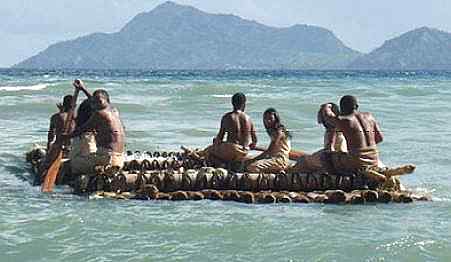
Flores to Timor on Hominid Raft |
Present day Sea Crossings
Strait of Dover: 21 mi. x 40 m *** Bering Strait: 80 mi. x 50 m *** Taiwan Strait: 100 mi. x 70 m *** Torres Strait: 150 mi. x 40 m *** Asia-Indonesia-Philippines *** Straits of Gibraltar 10 miles Entrance to Red Sea 20 mi. Cyprus to Coast 60 mi. Crete to Greece 60 mi. Timor to Australia 300 mi. (60 mi. during ice-age) Africa & Madagascar 300 mi.
- 21 mi. x 40 m : means 21 miles wide and 40 meters deep
- "***" means one could walk accross during Ice Ages when sea levels were up to 130 m lower